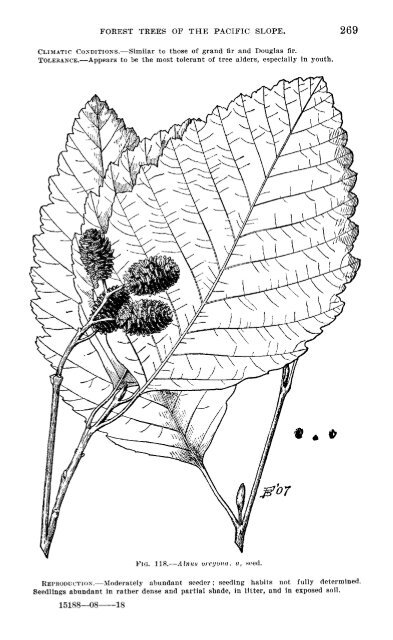De I. VNER VEW D Forest Trees of the Pacific Slope
De I. VNER VEW D Forest Trees of the Pacific Slope
De I. VNER VEW D Forest Trees of the Pacific Slope
Create successful ePaper yourself
Turn your PDF publications into a flip-book with our unique Google optimized e-Paper software.
FOREST TREES OF THE PACIFIC SLOPE. 131<br />
ness. They ripen early in September and begin to break up and fall from <strong>the</strong><br />
trees in October. The protruding, pointed bracts, which cover <strong>the</strong> cone scales<br />
as if <strong>the</strong>y were shingled, give <strong>the</strong> mature cones a light yellow-green color,<br />
which later turns to light yellow-brown. The seeds (fig. 51, a), dull red-brown,<br />
have shiny pale brown wings. Seed-leaves, 6 to 7, <strong>of</strong> uniform thickness throughout,<br />
with a short abrupt point.<br />
Wood, ra<strong>the</strong>r heavy, being one <strong>of</strong> <strong>the</strong> three <strong>Pacific</strong> firs with <strong>the</strong> heaviest wood<br />
<strong>of</strong> any <strong>of</strong> our species. It is moderately hard, firm, <strong>of</strong> medium fine grain, very<br />
light brown, irregularly marked with reddish-brown areas, which add much to<br />
<strong>the</strong> beauty <strong>of</strong> <strong>the</strong> wood. It works easily and well, deserving much wider<br />
recognition than it now enjoys for high-grade lumber. In quality it is entirely<br />
different from and superior to any <strong>of</strong> <strong>the</strong> light, very s<strong>of</strong>t fir woods. The<br />
magnificent, clean form <strong>of</strong> its trunks gives <strong>the</strong> finest <strong>of</strong> saw timber.<br />
LONGEVITY.-Much is still to be learned concerning its longevity. From what<br />
is now known it is doubtless long-lived, probably excelling all <strong>of</strong> our o<strong>the</strong>r firs<br />
in this respect. <strong>Trees</strong> from 20 to 30 inches in diameter are from 290 to 365<br />
years old. Very large trees have been observed, apparently perfectly thrifty,<br />
which would unquestionably show an age <strong>of</strong> from 600 to 700 years, if not more.<br />
RANGE.<br />
Coast ranges and Cascades <strong>of</strong> Washington and Oregon. Range still imperfectly known.<br />
WASHINGTON.-Northward to Mount Baker on both sides <strong>of</strong> Cascades, Olympic, and<br />
Coast mountains. Not detected on Vancouver Island. Nor<strong>the</strong>rn part <strong>of</strong> Washington<br />
National <strong>Forest</strong>, at about 3,000 to 5,000 feet; locally noted in Horseshoe Basin, Mount<br />
Amos, pass between Index and Montecristo. Both sides <strong>of</strong> Cascades in sou<strong>the</strong>rn part<br />
<strong>of</strong> Washington National <strong>Forest</strong>, at 2,200 to 4,800 feet in Cedar, Green, White, Yakima,<br />
Wenache, and Entiat river watersheds. Mount Rainier National <strong>Forest</strong>, at 3,000 to<br />
5,000 feet-sometimes down to 1,800 feet and up to 5,200 feet; abundant on Mount<br />
Rainier, at 4,000 to 5,000 feet; noted near Ashford, at 3,500 feet. Not detected on<br />
Mount Adams. North side <strong>of</strong> Olympic Mountains on Soleduc River, at about 3,000 feet,<br />
and general at higher elevations.<br />
OREGON.-Both sides <strong>of</strong> range in Cascade National <strong>Forest</strong> (North) ; west side, at<br />
1,400 to 6,000 feet; east side, southward only to latitude 45'. Locally noted on southwest<br />
side <strong>of</strong> Mount Hood at point 3 miles below Government Camp and upward, on north<br />
side at 4,500 feet; at elevations between 5,000 and 6,000 feet between North Fork<br />
<strong>of</strong> Clackamas River and Roaring Fork; this is <strong>the</strong> fir abundant on "Larch Mountain"<br />
In Clackamas watershed; Crater Lake on Wizard Island and from 4,600 feet on rim <strong>of</strong><br />
lake to top; Browder Ridge (nor<strong>the</strong>rnmost headwaters <strong>of</strong> McKenzie River, Lane County);<br />
north side <strong>of</strong> Siskiyous in Ashland National <strong>Forest</strong>. Reported extending southward in<br />
Coast Mountains nearly to Siskiyous.<br />
OCCURRENCE.<br />
Presence throughout range determined chiefly by abundant soil moisture, uniform, mild<br />
climate, and abundance <strong>of</strong> species competing with it. On gentle mountain slopes (<strong>of</strong> any<br />
aspect), depressions, benches, low ridges, and rolling plateaus. Vertical range increases<br />
from north to south and from coast eastward within a more or less fixed zone <strong>of</strong> heat and<br />
moisture. Latitude <strong>of</strong> range more restricted on east side <strong>of</strong> Cascades than on west,<br />
owing to lack <strong>of</strong> moisture and a severer climate. Thrives on moist, thin, rocky soils in<br />
cool situations, but best on deep, rich soils. Not so fastidious regarding quality <strong>of</strong> soil<br />
if abundant moisture is present.<br />
Very rarely in pure stands <strong>of</strong> even small extent; usually with Douglas fir, western<br />
hemlock, western white pine, or less commonly with yellow cedar, amabilis and alpine<br />
firs, lodgepole pine, and black hemlock. With Douglas fir and western white pine, <strong>of</strong>ten<br />
growing over western hemlock, western red cedar, and o<strong>the</strong>r tolerant species.<br />
CLIMATIC CONDITIONs.-Not fully determined. In general, climate <strong>of</strong> range is mild,<br />
and mainly without extreme daily or seasonal temperatures. Precipitation, heavy; considerable<br />
snow, which does not remain late.<br />
TOLERANCE.-Ra<strong>the</strong>r intolerant <strong>of</strong> shade for a fir, particularly in middle and late life,<br />
when rapid height growth forces crown above slower species and maintains It In full light.<br />
REPRODUCTioN.-Moderately prolific seeder. Some seed borne locally nearly every year,<br />
but good seed years occur at ra<strong>the</strong>r lone, infrequent intervals, <strong>Trees</strong> from 60 to 00

















